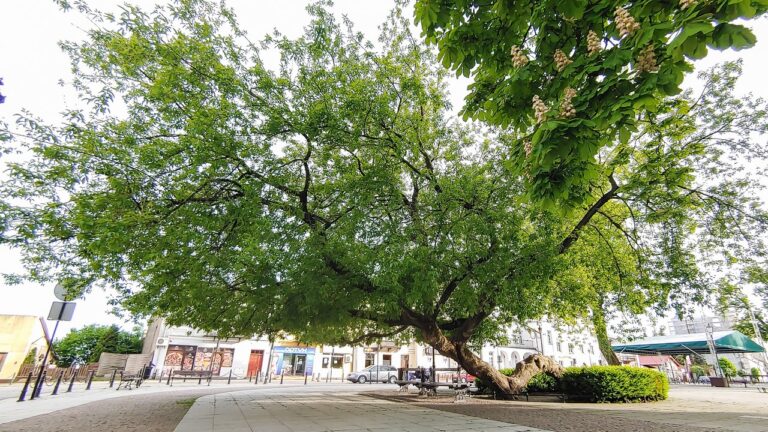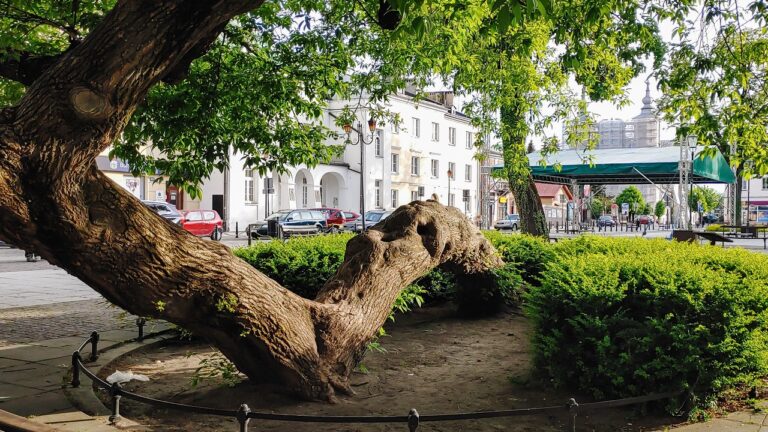Overview
A curiosity of a Krasnystaw park is a kneelig tree. It is an ashleaf maple growing at a town square. It is about 67 years old. Its special feature is the trunk construction. In 2018 this maple became ‘The Tree of the Year 2018’ in Polish edition of the contest organised by Gaja Club. In 2019 this tree represented Poland in a plebiscite - European Tree of the Year 2019.
Facilities
- Cafe nearby: yes
- Shooting possible: yes
- Parking for passenger cars: yes
Restrictions
- No walking on the tree
More interesting places
The former men’s gymnasium
The building administrated by Special School and Educational Centre has got quite rich history and at the same time important for the national identity of the society of Krasnystaw.
It was built at the beginning of the last century for the purpose of a casino for the officers of the tsarist garrison. During the period of intense fighting for Krasnystaw in the summer 1914 and in the summer 1915 military lazerat was located there. On January 3rd 1917 Austrian occupation authorities agreed to open a men's gymnasium for young people from Krasnystaw. It was the first Polish Real Gymnasium in Krasnystaw. It functioned for many years and over time girls also could study in this school. The first director of the Men's Gymnasium in Krasnystaw was a Polish officer, captain of Austro-Hungarian army Jan Wowczak. It is a classic example of the numerous presence of our compatriots in the uniforms of the armies of the partitioning states on almost every fronts of World War I. During World War II German occupiers closed the gymnasium, because Polish childern were not allowed to educated themselves more than in public school and vocational school. Over the period of the German occupation the garrison headquarters were located here. After war students came back to this building again. Special School and Educational Centre of the name of Maria Doroszewska began functioning here in 1968.
The manor complex
In the mid-nineteenth century, the lands of the complex belonged to the nearby Roman Catholic parish of St. Francis Xavier. The former manor house was erected in the first half of the nineteenth century. It was built in the classicist style, facing south. It is wooden, plastered and has a basement with a four-column portico from the front.
In 1865 the tsarist authorities confiscated the property, that came under the control of the empire's treasury, specifically the authorities of the governorate. It was leased first to the Dziewicki family, who lived in Krasnystaw for many years. After the stay of the Dziewicki family, a souvenir in the form of a modest building was left in our city. It is the grave of the family in the parish cemetery in Krasnystaw. The last tenants were the Radomyski family. Henryk Radomyski served as the mayor of Krasnystaw. He was arrested by Germans and murdered at the Lublin Castle in February 1942.
After 1944, the manor land was parceled out and the buildings were handed over to various institutions. The government estate "Starostwo Krasnostawskie" consisted of two manors before the war: „Starostwo”, on the territory of which the manor house stood and the grange "Rońsko". Currently, the manor house has undergone a thorough renovation and since October 2015 it has been the seat of the Center for Social Integration.
- The manor complex
- Sikorskiego 10, 22-300 Krasnystaw
The castle in Krupe
It is considered as the largest castle in Poland. It was erected on the eastern side of the Vistula River. The castle was built and expanded at the end of the XVI century on the site of the former family seat of the Krupski family by the Chełm chamberlain Paweł Orzechowski, coat of arms Rogala. It was expanded in 1604 – 1608. The castle was in the hands of the Orzechowski family until 1644. This historical building was located on a platform similar to a rectangle. An ensemble consists of the proper castle and the castle boroughs. These buildings form a closed fortified circuit. It is made of stone and brick. The castle proper is located in the western part and separated by an internal moat, included in the perimeter of the defensive walls with bastions on the north-east and south corners. In the area of castle boroughs there was once an economic courtyard with buildings and the main entrance from the north-east with a drawbridge and a gate. The castle was destroyed in 1648 – 1660 during the Cossack invasion and the Swedish Deluge. Since the second half of the XVIII century, the castle has been in ruins.
The town hall
The town hall is a flagship building in every city center. Soi t is in Krasnystaw. Archeologine research indicates that it was originally located in the middle of the town square. Burned down during the great fire of Krasnystaw which took place in 1878. The current town hall is a building from the beginning of the twentieth century. This is evidenced, for example, by postcards from Krasnystaw made in 1914, on which it is just visible. On websites it is erroneously stated that the town hall was built in the interwar period. However, it is only true that in the interwar period in 1928 it was rebuilt after serious destruction caused by the battles for the town in August 1914 and in July 1915. In recent years, the façade of the building has been restored.






